Alaverdi Monastery
by
Kathy & Terry Sullivan
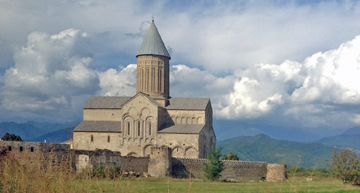 Summary: Wine enthusiasts, especially those with an interest in history, will enjoy a visit to Alaverdi Monastery where they can visit the centuries old cathedral, see aged qvevri, oak barrels and taste the monastery brand SINCE1011 wines.
Summary: Wine enthusiasts, especially those with an interest in history, will enjoy a visit to Alaverdi Monastery where they can visit the centuries old cathedral, see aged qvevri, oak barrels and taste the monastery brand SINCE1011 wines.
Visitors to Alaverdi Monastery near Telavi, Georgia will receive a warm welcome. A visit to Alaverdi Monastery begins with a visit to the church where frescos decorate the walls. After visiting the cathedral visitors, walk past young olive trees and a small vineyard inside the tall stone walls. Leaving the church area we passed by an area where qvevri from centuries earlier have been discovered. Some of these clay qvevris date back to the 8th to 10th centuries.
Monastery wine tastings take place in the renovated wine cellar behind the cathedral. Alaverdi Monastery produces qvevri wines and wines in oak barrels. They are sold to visitors and also exported. In the United States they are available on the East Coast and West Coast.
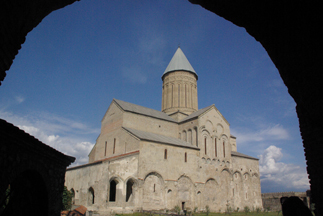 Alaverdi History
Alaverdi History
In the 6th century the Assyrian fathers entered this region to preach Christianity. One of the Assyrian fathers came to this spot and built a wood church. In the 11th century the current stone church was built and during the 19th century the outside fortress-style walls were added for protection.
The Alaverdi Monastery has been restored several times. During the Russian Empire era the walls inside the church were painted white to cover the religious frescoes. In the 1960s when the white paint was removed from some of the walls, the colorful frescoes were discovered.
In 2006 an archeological excavation just outside of the cathedral discovered wine cellars with qvevri dating from the 8th to the 10th centuries
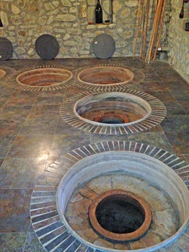 Qvevri Wines Today
Qvevri Wines Today
To produce qvevri wines the grapes are first destemmed and pressed. The juice and pomace are placed in the qvevri. The wines are made using indigenous yeast. The cap that forms at the top of the qvevri during fermentation is punched down three to five times daily. When this process is completed the top of the qvevri is covered with layers: a cover and then several inches of sand that is kept moist.
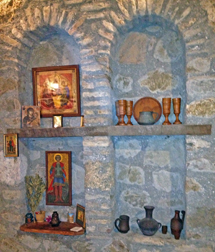 Today the SINCE1011 qvevri wines are produced by Father Grasim. He first helped his parents make wine saying that all of his ancestors made wine.
Today the SINCE1011 qvevri wines are produced by Father Grasim. He first helped his parents make wine saying that all of his ancestors made wine.
Qvevri are buried underground. The wine cellar has polished stone on the floor with several brick circles around the openings of qvevri. Once the grapes are done fermenting the qvevri is sealed. Throughout the cellar there were tops used to cover the qvevri opening and winemaking tools. Alcoves built into the stone walls of the room held artifacts. Adjacent to the qvevri room, another room had a wood press and oak barrels. Another room houses stainless steel tanks and oak tanks.
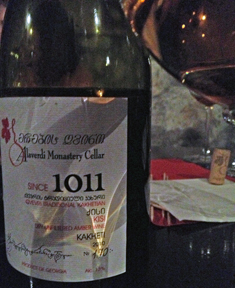 Qvevri Wines
Qvevri Wines
We tasted several wines with Father Gerasim. As we tasted wines, Father Gerasim noted, “Qvevri wines open your heart.” The wine will reveal its qualities at any temperature. Monks have made wine at Alaverdi Monastery since the year 1011. A line of wines is called SINCE1011. The SINCE1011 Rkatsiteli 2010 spent one and a half years in qvevri. The dark orange wine had an aroma and taste of dried fruit. The fruity finish had bold tannins. The monastery wines we tasted were aged longer in a qvevri. Kisi 2010 was a bronze color and offered notes of spices. The wine also had bold tannins and spice on the finish. Saperavi 2011 was a dark purple to black color. The wine offered dark fruits on the aroma and the taste had dark fruit notes. The wine had bold tannins and the finish was complex with black fruit notes. The wine could challenge Napa Cabernet Sauvignons.
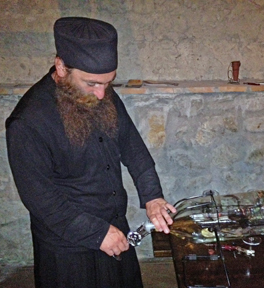 Monastery Chacha
Monastery Chacha
Chacha is made from distilling the chacha (pomace) after it is removed from the wine. Some people enjoy it by gulping down a small amount. The story behind gulping Chacha came from long ago. One time the devil and God had an argument over where people would go. God said he would take the people who have only one to three drinks of Chacha. Those who drink a fourth glass or more the devil could have. Georgians figured a way around this. Gulp the Chacha so quickly that the devil will not be able to count the number of drinks.
The Monastery Chacha had heat on the finish then a long dried fruit aftertaste. It warms the body and heart. Consider pairing this Chacha with the traditional Georgian confection Churchkhela, a dessert made with thickened grape juice and walnuts.
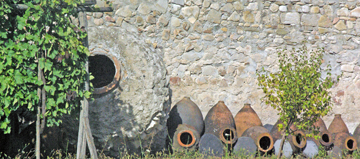 While visiting Telavi, Georgia be sure to travel to Alaverdi Monastery where you will discover the deep connections between wine, history and religion.
While visiting Telavi, Georgia be sure to travel to Alaverdi Monastery where you will discover the deep connections between wine, history and religion.
Alaverdi Monastery Cellar
Alaverdi, Kakheti, Georgia
